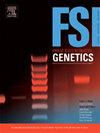有效利用人类DNA定量试剂盒的降解指数来改善STR和Y-STR分析
IF 3.1
2区 医学
Q2 GENETICS & HEREDITY
引用次数: 0
摘要
短串联重复序列(STR)基因分型主要用于各种法医生物样本的人类鉴定。然而,从犯罪现场或大规模灾难中收集的样本经常暴露在导致相当大的DNA降解的环境因素中。因此,由于可用于扩增的STR位点的有效拷贝数减少,降解的DNA产生的多态性信息明显少于未降解的DNA。为了获得可靠的STR结果,在精确的DNA定量的同时考虑DNA降解的程度是至关重要的。在本研究中,我们研究了DNA降解对STR和y染色体STR (Y-STR)分析中等位基因检测的影响,以改进PCR扩增对降解DNA数量的估计,提高等位基因的检出率。具体来说,我们分析了Quantifiler HP DNA定量试剂盒提供的降解指数(DI)与使用不同数量的人工片段化或紫外线照射的DNA进行STR和Y-STR分析时等位基因检出率之间的关系。我们的研究结果表明,DI是DNA降解的一个有价值的指标,有助于估计用于PCR扩增的降解DNA的适当数量。此外,即使在DI保持不变的情况下,STR和Y-STR谱和等位基因检出率也会根据降解模式(如破碎或紫外线照射)而变化。我们的研究结果强调了将DI纳入法医工作流程的重要性,以最大限度地从有限的降解DNA中恢复等位基因,最终增强法医和灾难受害者的识别。本文章由计算机程序翻译,如有差异,请以英文原文为准。
Effective use of the degradation index from human DNA quantification kits to improve STR and Y-STR profiling
Short tandem repeat (STR) genotyping is primarily used for human identification in various forensic biological samples. However, samples collected from crime scenes or mass disasters are often exposed to environmental factors that cause considerable DNA degradation. As a result, degraded DNA yields significantly less polymorphic information than non-degraded DNA due to a reduction in the effective copy number of STR loci available for amplification. To obtain reliable STR results, it is crucial to consider the degree of DNA degradation alongside accurate DNA quantification. In this study, we investigated the impact of DNA degradation on allele detection in STR and Y-chromosome STR (Y-STR) analyses to improve the estimation of degraded DNA quantity for PCR amplification and enhance allele detection rates. Specifically, we analyzed the relationship between the degradation index (DI) provided by the Quantifiler HP DNA Quantification Kit and allele detection rates in STR and Y-STR analyses using various amounts of artificially fragmented or UV-irradiated DNA. Our results demonstrate that the DI serves as a valuable indicator of DNA degradation, aiding in the estimation of the appropriate amount of degraded DNA for PCR amplification. Furthermore, STR and Y-STR profiles and allele detection rates vary depending on the degradation pattern, such as fragmentation or UV irradiation, even when the DI remains the same. Our findings underscore the importance of incorporating DI into forensic workflows to maximize allele recovery from a limited amount of degraded DNA, ultimately enhancing forensic and disaster victim identification.
求助全文
通过发布文献求助,成功后即可免费获取论文全文。
去求助
来源期刊
CiteScore
7.50
自引率
32.30%
发文量
132
审稿时长
11.3 weeks
期刊介绍:
Forensic Science International: Genetics is the premier journal in the field of Forensic Genetics. This branch of Forensic Science can be defined as the application of genetics to human and non-human material (in the sense of a science with the purpose of studying inherited characteristics for the analysis of inter- and intra-specific variations in populations) for the resolution of legal conflicts.
The scope of the journal includes:
Forensic applications of human polymorphism.
Testing of paternity and other family relationships, immigration cases, typing of biological stains and tissues from criminal casework, identification of human remains by DNA testing methodologies.
Description of human polymorphisms of forensic interest, with special interest in DNA polymorphisms.
Autosomal DNA polymorphisms, mini- and microsatellites (or short tandem repeats, STRs), single nucleotide polymorphisms (SNPs), X and Y chromosome polymorphisms, mtDNA polymorphisms, and any other type of DNA variation with potential forensic applications.
Non-human DNA polymorphisms for crime scene investigation.
Population genetics of human polymorphisms of forensic interest.
Population data, especially from DNA polymorphisms of interest for the solution of forensic problems.
DNA typing methodologies and strategies.
Biostatistical methods in forensic genetics.
Evaluation of DNA evidence in forensic problems (such as paternity or immigration cases, criminal casework, identification), classical and new statistical approaches.
Standards in forensic genetics.
Recommendations of regulatory bodies concerning methods, markers, interpretation or strategies or proposals for procedural or technical standards.
Quality control.
Quality control and quality assurance strategies, proficiency testing for DNA typing methodologies.
Criminal DNA databases.
Technical, legal and statistical issues.
General ethical and legal issues related to forensic genetics.

 求助内容:
求助内容: 应助结果提醒方式:
应助结果提醒方式:


